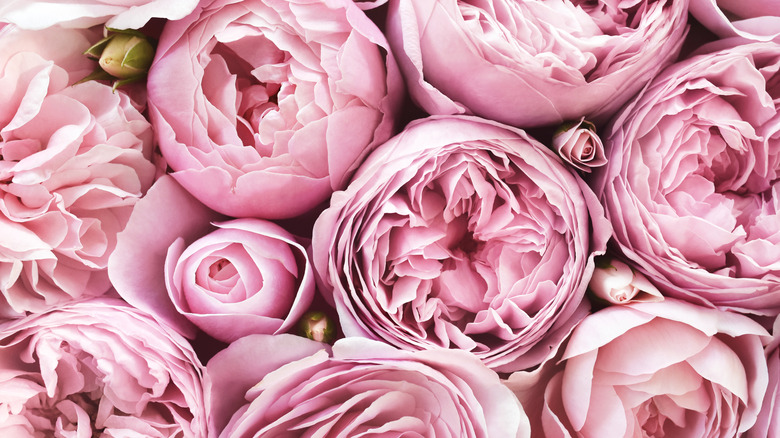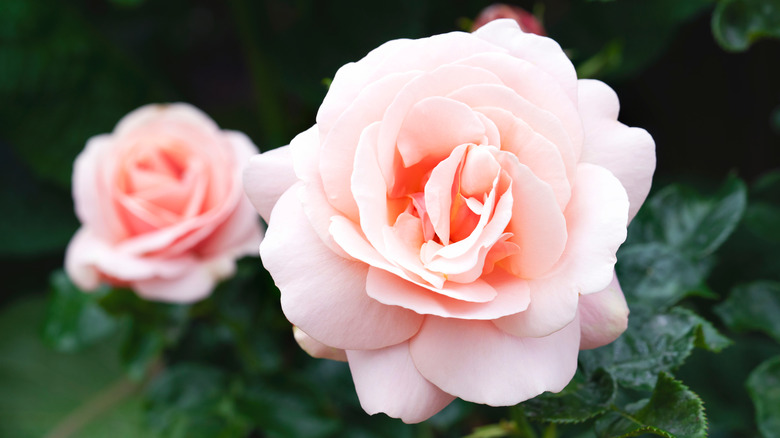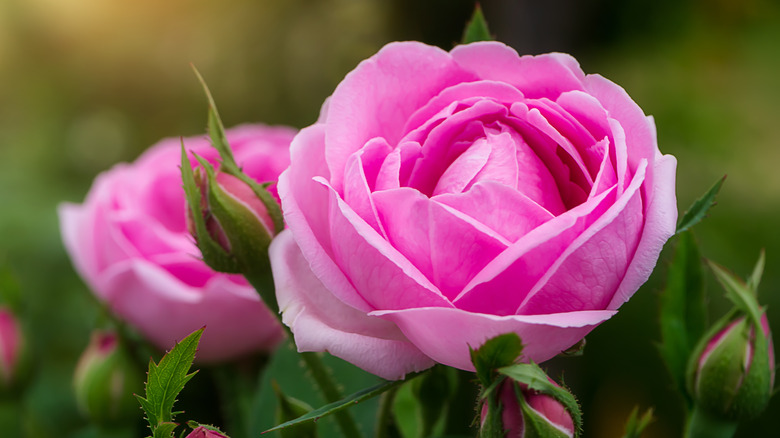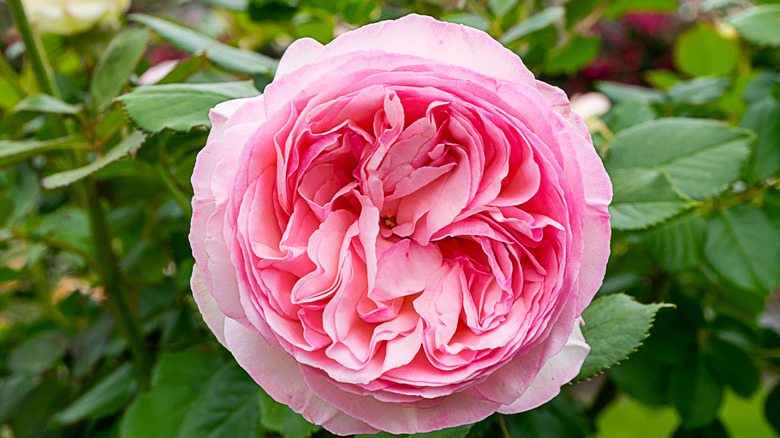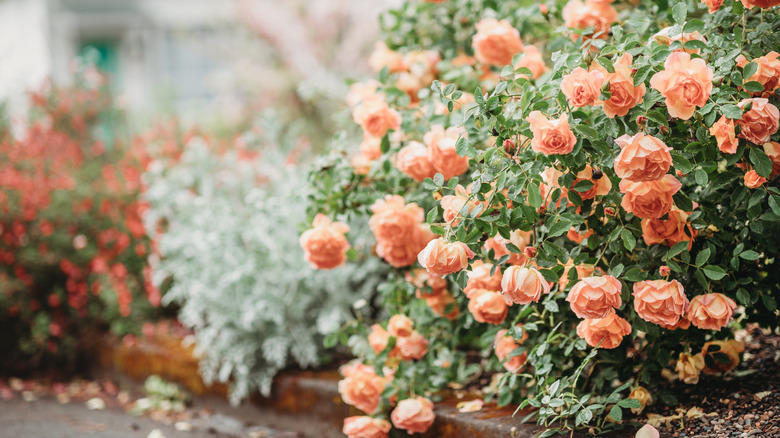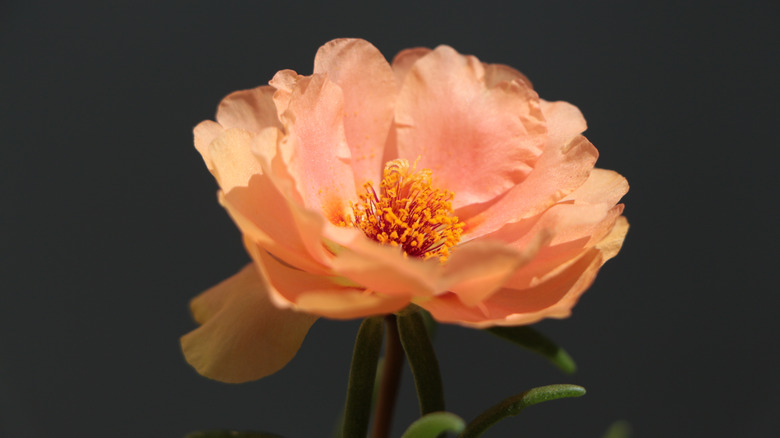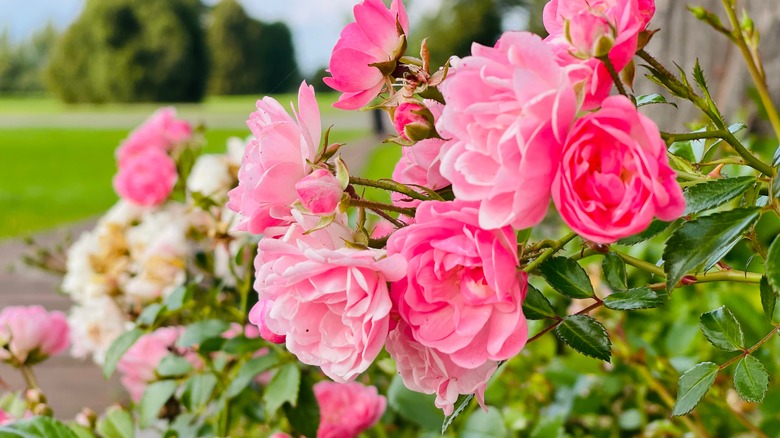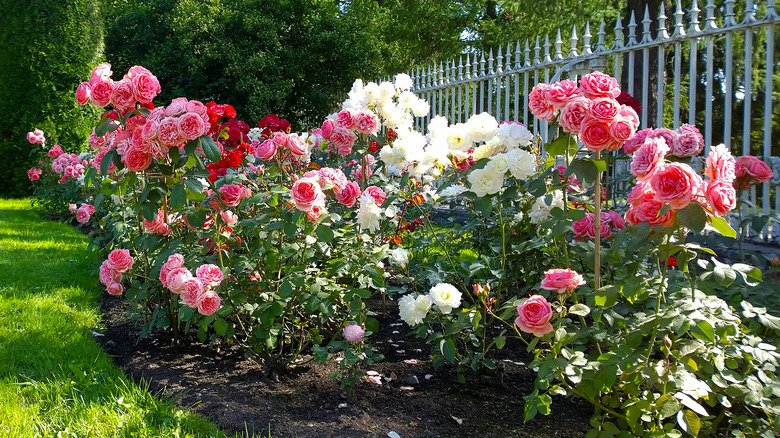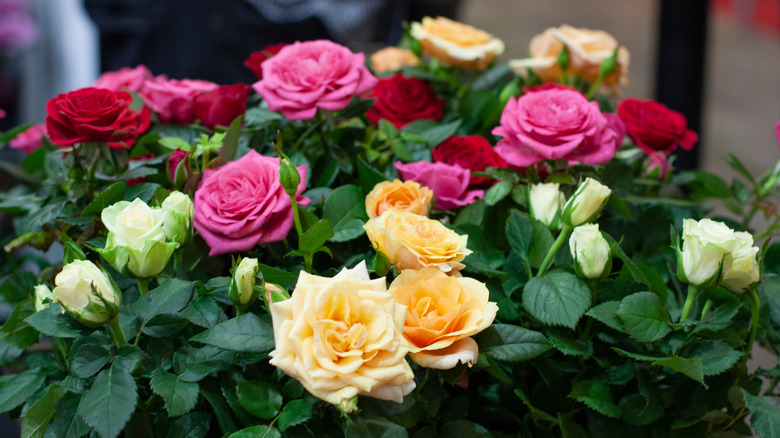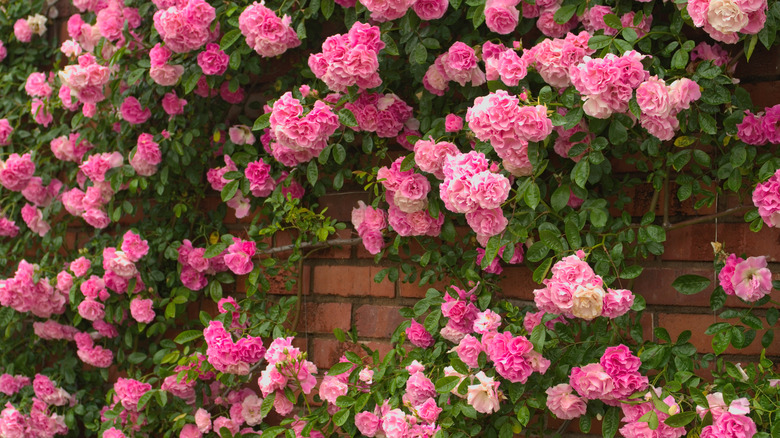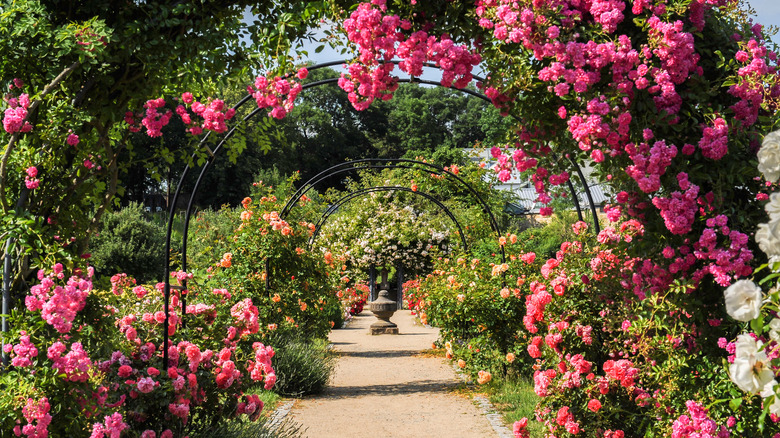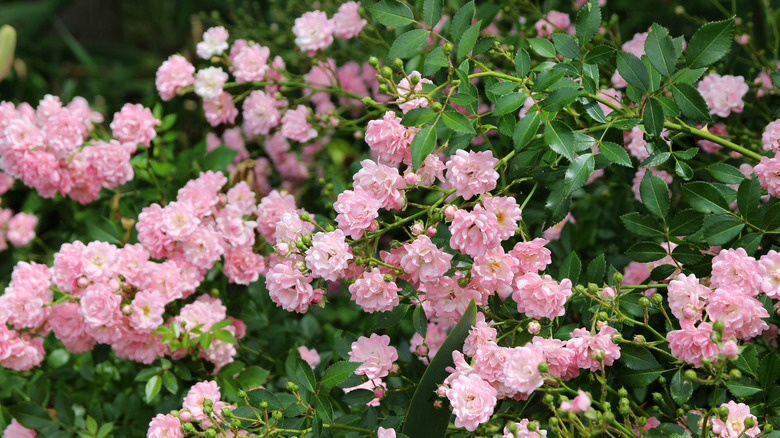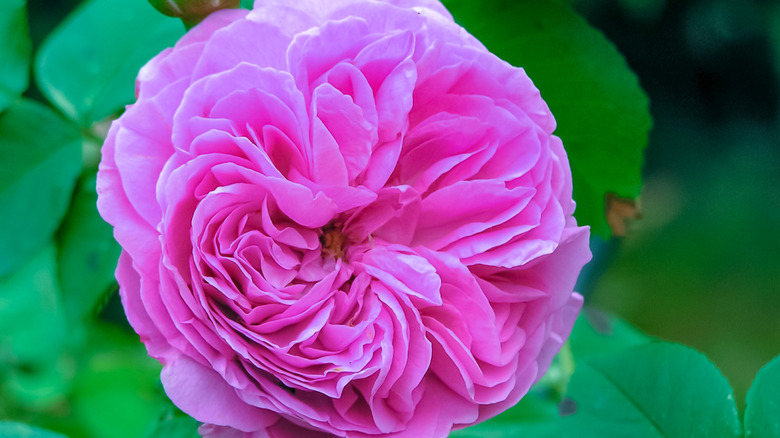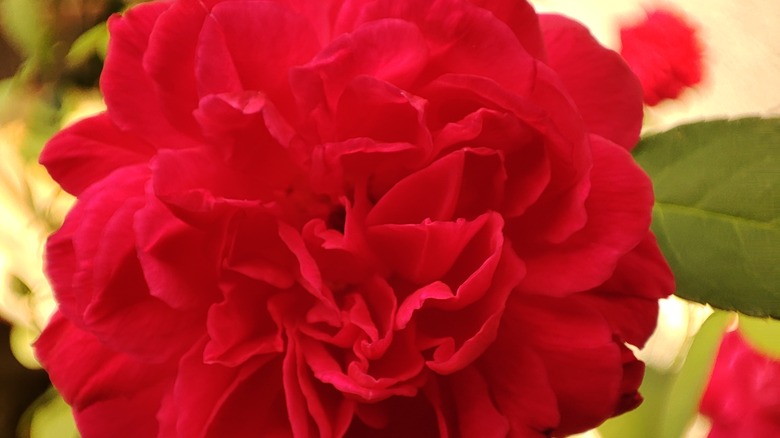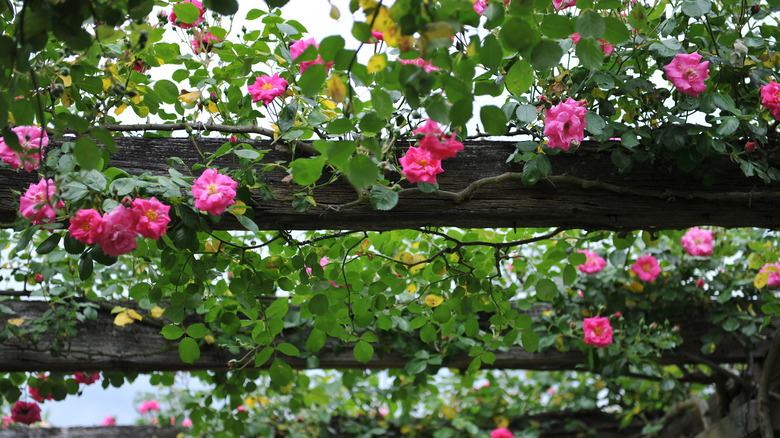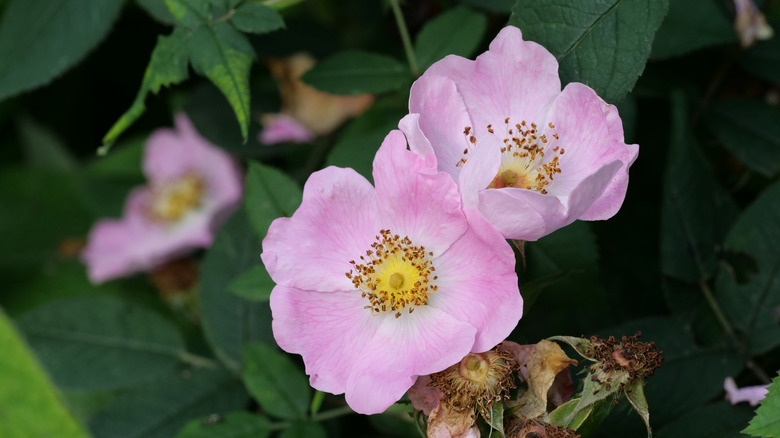15 Different Rose Bush Types You Should Know About
"That which we call a rose by any other name would smell as sweet." William Shakespeare knew the appeal of roses when he wrote "Romeo and Juliet," and it's an appeal that still holds today. There are so many types of roses available, and that number only seems to be growing as hybridization becomes increasingly popular.
Generally speaking, roses can be split into three primary categories: Old Garden Roses, Wild Roses, and Modern Garden Roses. Old Garden Roses refer to ancestral varieties that have been around since at least 1867. Wild Roses are varieties that have never been cross-bred. They typically have five petals and are most often pink. Modern Garden Roses have been bred or created as hybrids since 1867. They bloom for longer periods and tend to have larger flowers.
In this article, we'll tell you about 15 of the most popular types of rose bushes and break down the pros and cons of each one.
1. Hybrid tea roses
Hybrid tea roses (Rosa x hybrida) are one of the most popular types of roses in the world because of their beauty, intoxicating fragrance, and low-maintenance care requirements. They have been cross-bred to bloom several times throughout the season by combining the positive attributes of hybrid perpetual roses and Old Garden tea roses. Certain varieties are mildew-resistant, making them a great choice for humid climates.
Bloom Season: May to frost
USDA Growing Zone: 5 to 9
Growing Conditions: Full sun
Soil Type: Well-drained, loamy
Size: 3 to 8 feet tall and 2 to 3 feet wide
2. Damask roses
Damask roses (Rosa damascena) are an Old Garden variety, and in fact, it is believed that they have been around since the time of Ancient Rome. As ancestral varieties, they typically only bloom once per season, though some varieties do exist that bloom in autumn as well. While they don't necessarily have a remarkable fragrance, they are popular for rose oil production. They're cold-resistant, making them an excellent choice for gardeners living in cooler climates.
Bloom Season: Spring and autumn
USDA Growing Zone: 4b to 9b
Growing Conditions: Full sun
Soil Type: Fertile, well-drained
Size: Up to 7 feet tall and wide
3. Centifolia roses
Also known as Cabbage roses, Centifolia roses (Rosa centifolia) are typically deep pink in color and are incredibly fragrant, making them a great addition to any home garden. When planted alone, Centifolia roses typically need supports to allow them to grow vertically. While their original provenance may be uncertain, they were popularized by the Dutch.
Bloom Season: Early to late summer
USDA Growing Zone: 4 to 9
Growing Conditions: Full sun
Soil Type: Sandy, loamy, some clay
Size: Up to 6 feet tall and 5 feet wide
4. Floribunda roses
Floribunda roses (Rose floribunda) were created as a hybrid between the popular polyantha roses and hybrid tea roses and were bred to be disease-resistant and hardy and to produce showy blooms. Their flowers may be small, but each branch features a cluster of them rather than a single bloom. One of the major benefits of this type of rose is that they require very little in the way of pruning, making them a low-maintenance pick.
Bloom Season: Spring to autumn
USDA Growing Zone: 4 to 9
Growing Conditions: Full sun
Soil Type: Well-drained, fertile
Size: Up to 8 feet high and 6 feet wide
5. Grandiflora roses
Grandiflora roses are another type of hybrid, created from breeding hybrid tea roses and Floribunda roses. This combination allows for multiple flowers to grow on a single branch, but they're comparatively larger than those found on Floribunda rose bushes. They can withstand colder conditions than their predecessors, making them a popular choice in northern climates. When cut, they have a long lifespan in a bouquet.
Bloom Season: Summer
USDA Growing Zone: 5 to 9
Growing Conditions: Full sun
Soil Type: Well-drained
Size: 3 to 4 feet tall and 2 to 3 feet wide
6. Polyantha roses
The first Polyantha rose was introduced by Jean-Baptiste Guillot in 1875. He created it by crossing R. multiflora and R. chinensis. The resulting variety was able to bloom multiple times per year and was thus given the name "polyanthas," which means "many flowers" in Greek. This variety can thrive in zones 4a to 9b and is one of the smaller types of roses, growing to just 4 feet in height.
Bloom Season: Mid-spring
USDA Growing Zone: 4a to 9b
Growing Conditions: Light shade to full sun
Soil Type: Fertile, rich in humus
Size: 2 to 4 feet high and 2 to 4 feet wide
7. Shrub roses
Also known as Landscaper's roses, Shrub roses (rosa) are popular around the country because they're hardy to zone 3. They come in a wide variety of colors and are easy to care for, making them a great choice for beginner gardeners. They can be grown in containers and also thrive on hillsides and sloped pieces of land.
Bloom Season: Late spring to frost
USDA Growing Zone: 3 to 11
Growing Conditions: Full sun to light shade
Soil Type: Fertile, well-draining
Size: 1 to 20 feet tall and 1 to 15 feet wide
8. Miniature roses
Rosa spp., more commonly known as the miniature rose, has been bred to produce small blooms. While they're now created intentionally, they originated as mutations of regular rose varieties. They tend to be quite hardy, and many varieties bloom several times throughout the year. Because of their small flowers, they're a great choice for container gardening, where they can be seen more easily at eye level.
Bloom Season: Late spring to summer
USDA Growing Zone: 5 to 9
Growing Conditions: Full sun
Soil Type: Moist, well-drained
Size: 1 to 2 feet tall and 1 to 2 feet wide
9. Rambler roses
Rambler roses, also known as multiflora roses (Rosa multiflora), are a much-desired variety because of their ability to be trained on fences, pergolas, walls, and trellises. They have an impressive ability to spread, reaching maximum heights of 30 feet and widths of 100 feet. They differ from climbing roses in that they typically only bloom once per year. Some newer varieties do exist, however, that are able to bloom multiple times.
Bloom Season: Spring to early summer
USDA Growing Zone: 4 to 9
Growing Conditions: Full sun, partial sun
Soil Type: Moist, well-drained
Size: Up to 30 feet tall and 100 feet wide
10. English roses
English roses (Rosa) were created by David Austin in the 1960s. Over the years, he has bred several varieties by crossing Hybrid tea roses with Damask roses, Alba roses, and Gallica roses. They bloom in nearly every color, with plenty of varieties for gardeners to choose from. They are, however, somewhat high maintenance, requiring regular pruning.
Bloom Season: Spring to fall
USDA Growing Zone: 4 to 10
Growing Conditions: Full to partial sun
Soil Type: Nutrient-rich
Size: Up to 20 feet tall and 5 feet wide
11. Groundcover roses
Technically speaking, groundcover roses (Rosa) aren't a specific breed of rose but encompass many different varieties that grow low to the ground, making them an excellent addition to many gardens. They are typically resistant to disease and add plenty of color to any space. As an added bonus, they bloom continually from spring to fall.
Bloom Season: Spring to fall
USDA Growing Zone: 5 to 9
Growing Conditions: Full to partial sun
Soil Type: Well-drained with organic matter
Size: Up to 8 feet tall and up to 4 feet wide
12. Bourbon roses
The Bourbon rose (Zephirine Drouhin) is both popular and widely available, according to Dave's Garden. It has all of the attributes that rose gardeners tend to seek out: It's fragrant, it can bloom multiple times per year, and it's relatively easy to care for. Some varieties are even thornless, making them easier for gardeners to work with. While Bourbon roses can tolerate some shade, they are most disease-resistant when grown in full sun.
Bloom Season: Spring to summer
USDA Growing Zone: 5 to 9
Growing Conditions: Full sun to partial sun
Soil Type: Moist but well-drained
Size: Up to 10 feet tall and 6 feet wide
13. China roses
The Rosa chinensis or China rose isn't named due to its Chinese origin; in fact, it's unknown what the source of this hybrid is. Some sub-varieties of China rose like "Mutabilis" bloom all season long from spring to the first frost. One downside of this variety is that it can only be grown in a limited area in North America, in USDA zones 6 through 9.
Bloom Season: Spring to first frost.
USDA Growing Zone: 6 to 9
Growing Conditions: Full sun to partial shade
Soil Type: Fertile, moist, well-drained
Size: Up to 10 feet tall and 6 feet wide
14. Noisette roses
The Noisette rose (Rosa noisettiana) gets its name from the man who hybridized it: Philippe Noisette. This variety is known for its extremely fragrant blooms, making it a great choice for gardeners who like to stop and smell the roses. They tend to be tall plants with clusters of relatively small flowers that have a natural, informal look.
Bloom Season: Late spring to early summer
USDA Growing Zone: 6a to 10b
Growing Conditions: Full sun
Soil Type: Mildly acidic
Size: Up to 10 feet tall and 6 feet wide
15. Prairie rose
Rosa setigera, more commonly known as the Prairie rose, is the state flower of both Iowa and North Dakota but is found naturally in many parts of the country. While it is a wildflower, it can also be cultivated in gardens. The flowers these shrubs produce range in color from pale to deep pink and typically have five petals per flower.
Bloom Season: Spring and summer
USDA Growing Zone: 5 to 8
Growing Conditions: Full sun
Soil Type: Moist, well-drained
Size: Up to 12 feet high and 9 feet wide
